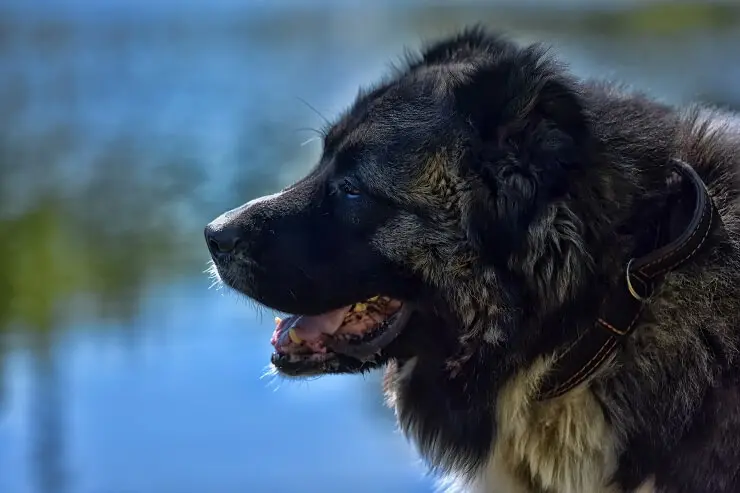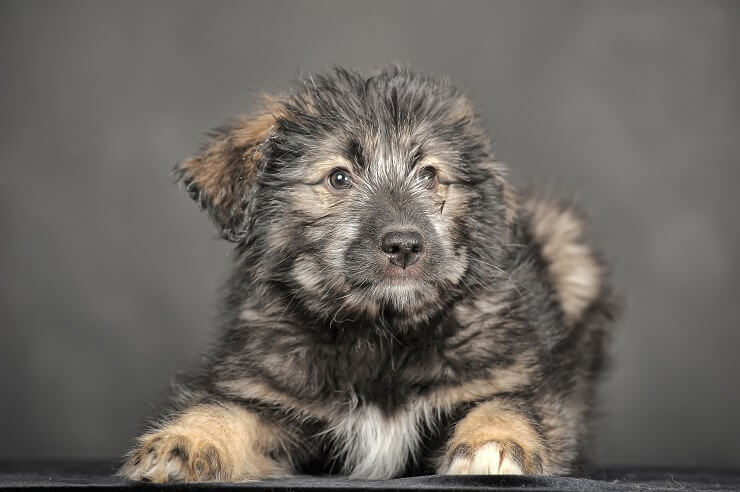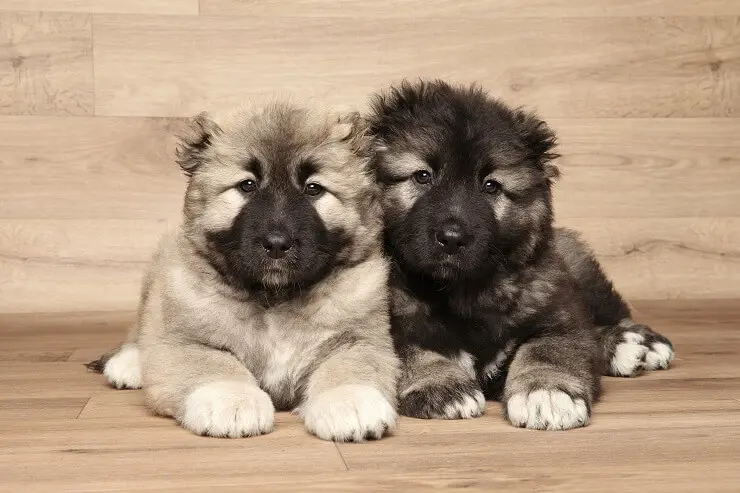Russian Bear Dog Temperament and Personality
The Russian bear dog is a confident, loyal, high-energy dog that’s fiercely protective of its family and wary of strangers. The breed is independent, intelligent, and alert.
The dog is known to be challenging to train. A first-time dog owner or person inexperienced with canine behaviors shouldn’t own a Russian bear dog.
Although Russian bear dogs have protective guarding instincts, the dogs’ barking tendencies are low. The dogs bark when they sense a threat, such as strangers entering their home, but the breed isn’t known to bark excessively due to boredom or anxiety.
Socialization from a young age should prevent excessive barking at strangers.

Russian bear dogs are large dogs with high exercise and food requirements. Taking care of the dogs is challenging and expensive.
The Russian bear dog needs 8 to 10 cups of good-quality kibble per day. To reduce the risk of bloat, puppies’ food should be divided into four meals per day. Adults should eat two or three separate meals per day.
The dog’s size and activity level affect its food requirements, so speak to your veterinarian if you’re unsure exactly how much food your dog needs.
The Russian bear dog’s long, thick coat should be brushed at least twice a week, or up to once per day during shedding season. Use a slicker brush to detangle knots in the undercoat, gently brushing in the direction that the fur grows.
Wash the dog every four to six weeks, or when the coat looks dirty and begins to smell unpleasant.
Russian bear dogs need at least one hour of exercise per day, divided into a minimum of two separate walks. This dog is unsuitable for apartment living because it needs constant access to a backyard to stretch its legs between exercise sessions
To prevent skeletal development abnormalities in this breed, exercise the dog while it’s still a puppy. The duration of exercise for a puppy is five minutes for every month of age.
For example, a five-month-old puppy should be exercised for a maximum of 25 minutes.
The Russian bear dog needs at least 30 minutes of mental stimulation per day to maintain its great intelligence. Games like fetch, frisbee, and find-and-retrieve are stimulating for this breed.
Puzzle toys are a good way to keep the dog entertained while you’re busy, but finding a suitably-sized toy for this large dog can be difficult.
Common health issues the Russian bear dog faces include:
As a large dog breed, the Russian bear dog is prone to elbow and hip dysplasia. These conditions cause the hip and elbow joints to form incorrectly, resulting in lameness, limping, pain, stiffness, and a “wobbly” walk.
Avoid hip and elbow dysplasia by buying a puppy from a breeder who has cleared the parent dogs of these conditions. Hip and elbow dysplasia is treated with exercise therapy, a controlled diet, weight loss (if necessary), and surgery.
Bloat, or gastric dilation and volvulus (GDV), is the accumulation of gas or fluid in the stomach, and primarily affects large dog breeds like the Russian bear dog.
Signs of bloat include a swollen, hard belly, retching but not vomiting, drooling, excessive panting, and restlessness.
Reduce the risk of bloat by feeding the dog multiple small meals instead of one large meal, avoiding elevated food bowls, and restricting exercise immediately before and after meals. Bloat is life-threatening and causes death if not treated immediately with surgery.

Russian bear dogs are easy to train but can be stubborn, so they need to be trained from a young age with reward-based training and positive reinforcement.
The dogs have a wary nature, so they should never be trained with punishments.
Begin training and socializing this dog at eight weeks old, starting with leash and toilet training. Then, teach the dog important commands, like “sit” and “heel.”
Introduce the dog to a variety of people, other dogs, and situations in a safe, controlled manner.

Russian bear dogs are expensive. Adopting an adult dog is much cheaper than buying a puppy, but the dogs are rarely available for adoption.
Is a Russian Bear Dog Right for You?
The Russian bear dog is a beautiful, intelligent dog. However, due to its large size and protective nature, the dog isn’t suitable for some people or lifestyles.
Russian Bear Puppies – Before You Get One
These dogs are not for the faint of heart or the first-time dog owner. Their ancient protective instincts are still powerful today, which makes them a force to be reckoned with. They face threats head-on. This makes them the perfect dog to have watching your livestock or protecting your house.
However, they are not always suitable as your average companion dog. They need a lot of training and socialization to be well-adapted and friendly. This requires a lot of one-on-one work and training from a young age. As you might imagine, not every pet owner is up to the time commitment.
Despite what you may think, though, this dog is not terribly active and doesn’t need much exercise. They’re more of a “fifty-mile-per-hour couch potato.” They can go fast when they want to, but they’d usually much rather lay around.
Caucasian Shepherd Brutal Russian Bear Dog
| Height: | 23-30 inches |
| Weight: | 99-170 pounds |
| Lifespan: | 10-12 years |
| Colors: | Black, brown, and fawn with white markings |
| Suitable for: | Experienced dog owners, those who need a guard dog |
| Temperament: | Protective, bold, fearless |
Also known as the Caucasian Shepherd dog, this dog was bred to be a serious guard dog. Their original job was to protect flocks of all kinds from wild predators, and they were very good at their job.
Today, they are mostly a companion animal. However, they are only particularly common in some areas of the world, making them difficult to find in the United States.
This canine is bold and fearless. They are very self-confident when a threat is present, which is what made them such good guard dogs. However, they are also gentle with their family members, including other pets.